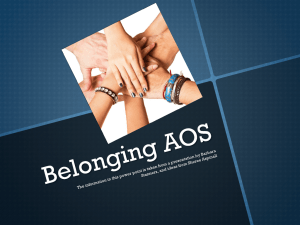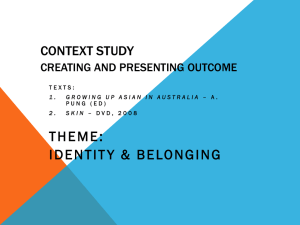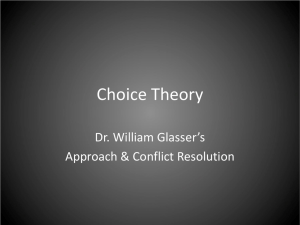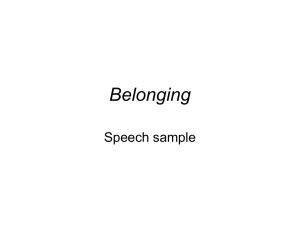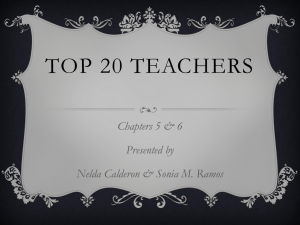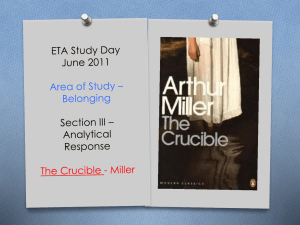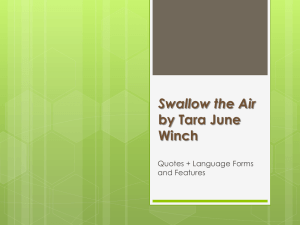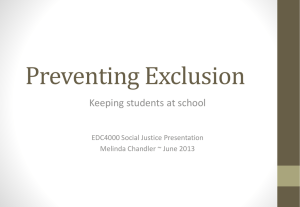Karen Yager Belonging PowerPoint
advertisement
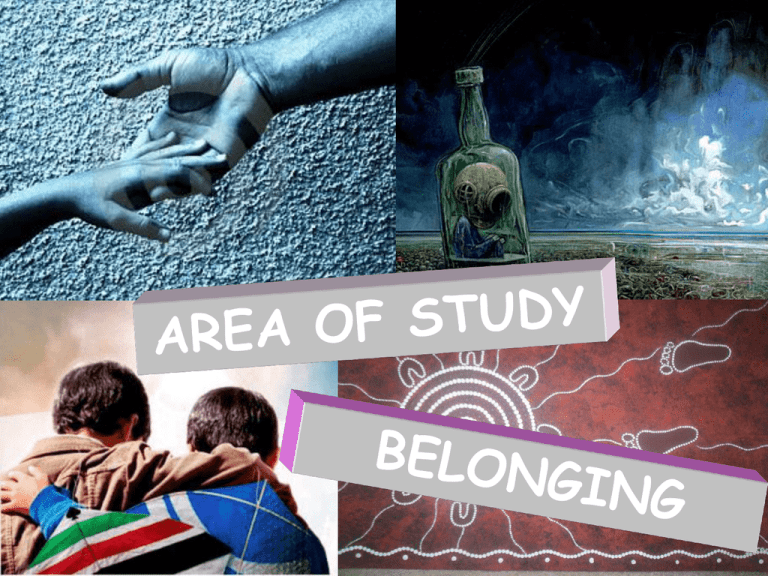
Meaning Perceptions: interplay of recognition and interpretation and is influenced by our preconceived ideas, memories, experiences and senses Meaning Text Meaning Meaning Composer Meaning Assumptions about belonging Meaning Context & Perspectives: personal, cultural, historical, social Meaning Representation of belonging through language features and ideas Context & Perspectives: personal, cultural, historical, social Responder Perceptions: interplay of recognition and interpretation and is influenced by our preconceived ideas, memories, experiences and senses The Concepts Representation: You need to explore, critically analyse and evaluate why and how the texts have used textual features and forms to shape meaning and influence responses. Contextualisation: How your personal, cultural, social and historical context affects your perspective of belonging. Integrate the significant aspects of context throughout your response. Interrelationships: You need to find other texts that enable you to make meaningful connections with your prescribed text. These texts of your own choosing should support and challenge how your prescribed text represents belonging ensuring that you can develop a range of informed theses or lines of argument. The Concepts Perceptions: You must take into consideration the composers’ contexts and your own context to appreciate how they interpret belonging and how you respond to this perception of belonging. Perception refers to the interplay of recognition and interpretation and is influenced by our preconceived ideas, memories, experiences and senses. It can alter and even distort how we view the notion of belonging. The Concept of Belonging How do you view the notion of belonging? Do the texts invite you to belong to their worlds? How do the texts represent the concept of belonging? How does your perception and assumptions about belonging compare with that of the composers you are studying? Has your perspective been challenged or altered? What lines of argument have you developed as a result? ‘Man – a being in search of meaning.’ Plato What do the texts tell you about the human experience? Section 1: Reading Task “Strong responses demonstrated perception and insight into the ideas embedded in the texts and supported a thesis with effective textual evidence.” “Weaker responses simply described the content of either the written or visual without linking them” “A discussion which focused primarily on language techniques often restricted the candidates’ opportunity to demonstrate their understanding of the ideas in the texts or to develop their ideas effectively” Reading Task The ideas! Composer’s purpose and attitude towards belonging How language features, form and structure represent belonging How you respond personally to the ideas in the texts. Reading Task What is being said about Belonging – the ideas How the composer shapes understanding of and the response to the concept of ‘Belonging’ - Identify the feature - Exemplify the feature - Explain the impact of the feature - Extrapolate by discussing why the composer used the feature Reading Task Assumptions about belonging that have shaped the representation. Different perspectives on belonging. Synthesis in final question Tactics - Highlighting Overarching theme Final question: Concept driven Line of argument in first topic sentence - Synthesis - Mini-essay - End with an evaluative statement Imaginative Writing Writing is a craft that can be learned and transformed to become artistry! Explicitly focus on the craft and artistry! Notes from Marking Centre ‘responses displayed originality and artistry and the mechanics of language were applied skilfully’ 2010 Feedback. ‘They explored the ways relationships contribute to a sense of belonging with insight, complexity and/or subtlety. These responses displayed originality and artistry and the mechanics of language were applied skillfully’ 2009 Feedback. ‘They demonstrated structural complexity, cohesion, the use of an authentic, sustained and engaging voice…mechanics of language, punctuation, sentence structure and paragraphing were applied skillfully in these responses’ 2007 Feedback. Marking Criteria Composes skilfully an engaging piece of imaginative writing using one of the quotations as the opening Skilfully explores the challenges of belonging and not belonging Demonstrates skilful control of language and structure appropriate to audience, purpose, context and selected form Artistry - Structure: Paragraphing Introduction Closing Cohesion: The idea Setting Motif or extended metaphor Artistry Voice: - Writing from experience - Word choice Subtlety: - Tension - Ambivalence A lost song I could hear her playing as I trudged down the road from the bus stop, that intricate melody dancing on the breeze. She spun a web of golden song around her as she caressed the strings gently with her bow. No one else could make the music sound quite like that, one minute a whispering laughing child, the next, a full-blooded passionate flamenco dancer. It was as though she was back, the mother that I used to have, the one from before… Artistry Mechanics: - Syntax: varying length and beginnings - Lexical density - Imagery: figurative devices/synathaesia - Sound: euphony, discordance, disruption - Verbs not adjectivous Artistry - Characterisation: Idiosyncrasies Talismans Complexity Perspectives and values How they move and act in the setting - Dialogue and voice - Relationships - Actions and consequences There’s a nothingness on the horizon that watches and waits. Nothing. I turn around and look back at the empty beach. There is no other place I want to be. I see a set coming. Digging deep into the ocean I gain speed and push my way onto the wave. A great force pushes me on and on. A huge rush of adrenalin kicks in as I stand up and fly down the glassy face. For that split second nothing else matters. No thoughts in my mind about school or my future or anything. All that matters is here on this wave. I don’t care what will come next… Activities Spotlighting at the word and sentence level Recording writing 12 word novels A newspaper headline or recent event Writing backwards Two to three scenarios Section III: Extended Response Must demonstrate understanding of key concepts and ideas of belonging from the rubrics and through the response to the texts Develop theses or lines of argument Choose texts that connect with concepts Notes from the Marking Centre ‘Candidates who clearly understood the purpose of their texts were able to demonstrate conceptual understanding and respond personally.’ ‘High-range responses … displayed an ability to evaluate and analyse.’ ‘an insightful thesis, which was sustained throughout the response through a discerning selection of textual detail… skilful integration of the analysis of both texts into the conceptual framework of their response was a distinguishing feature of highly developed responses. These responses were also marked by clear and purposeful control of language, with a judicious use of related material.’ HSC Examination Rubrics In your answer you will be assessed on how well you: demonstrate understanding of the concept of belonging in the context of your study analyse, explain and assess the ways belonging is represented in a variety of texts organise, develop and express ideas using language appropriate to audience, purpose and context Extended Responses Conceptual understanding: - The thesis or line of argument - In response to the question - The framework and drivers for extended responses - Integrates the response - Support and challenge Developing a Thesis Strong opening paragraph that introduces a clear line of argument or thesis that directly addresses the question. A response that is driven by a thesis connected to the question. Each successive point must further the thesis through textual analysis and support. Support or even challenge then thesis through the analysis of the text/s. Precise topic sentences that are connected to and build on the thesis. Developing a Thesis The human experience: Overarching idea first…. When developing theses students should consider that the notion of belonging is never fixed. It is constantly shifting depending on the individual’s experiences, emotional state and relationships with self and others. They need to consider how humanity’s flaws and qualities challenge and enrich belonging. Regard belonging as an ambivalent notion. Explore when and why individuals move between belonging, indifference and alienation. Ambivalence Alienation Belonging Theses Overarching through the question to specific lines of arguments. Supporting the thesis with the reasons why the student has arrived at this point of view. At least two – three supporting arguments used to further the thesis that addresses the question in the essay. E.g. The greatest barrier to belonging is the self: our perceptions, assumptions and degree of self-efficacy. Feelings of belonging are constantly changing due to societal pressures and expectations. Some individuals choose to change personally to conform and belong or to stand alone. This concept of belonging is conveyed through the representations of people and their relationships with others and the larger world in the play The Crucible and the film Social Network. Strong individuals choose not to belong to a society to preserve their individual and professional identity, and this can either enrich or challenge the values of a community or group. Developing a Thesis Judicious textual support: Detailed, relevant examples from the text/s rather than spurious, shallow examples. Supporting the analysis of language features with examples from the text/s and evaluating their impact on the responder. Never a shopping list of techniques! Begin with the idea, move to the textual detail and then analyse the language features and the meaning conveyed. Integration Making connections between the texts through: - The thesis - Characters - The act of representation Connecting words: Furthermore, alternatively… Lines of Arguments We spend our lives trying to belong to self, a place and others, not realising that it is our perceptions and attitudes that enable us to belong. When we begin to understand the forces that drive us to belong we develop empathy for others and personal insight. The simple act of unquestioning friendship and kindness nurtures the notion of belonging. When individuals experience a strong connection to a place the notion of belonging is strengthened and enriched. Theses The pressure to belong and conform has the potential to threaten individuality and independent thought. Belonging to a community or a group is not always a positive thing. To maintain the cohesion, power and authority of the community or group, individuals could be forced to conform and suppress their individuality. Freedom and independence can become casualties of conformity. Theses Humanity’s insecurities and flaws are the greatest challenge to belonging. A strong sense of identity ensures that an individual can deal with challenging circumstances. Belonging may be a fundamental human need but it also a choice: “I thank you for your company, but, good faith, I had as lief have been myself alone.” Suggested Approach Paragraph 1: Immediately address the question and introduce the thesis or line of argument that challenges or supports it. Provide at least one or two supporting arguments through an explanation of the thesis. Paragraph 2: Connect to the question and the thesis using a topic sentence. Then connect to the prescribed text by discussing whether the text supports or challenges the question. Integrate the significance of the composer’s context and times, and his or her perspectives, and how these influence the text’s representation of belonging and the underlying assumptions of the text about belonging. Suggested Approach Paragraphs 3 - 5: Connect the topic sentence to the previous paragraph and build on the thesis. Use the question and the associated thesis or line of argument to discuss those aspects of the text that are relevant. Integrate an analysis of the textual features and details that convey belonging. Use quotes from the text, but don’t use lengthy quotes that are not explained or linked to your discussion. Make connections with one or more of the other texts through the thesis, characters’ responses to belonging or language features used to represent belonging. Texts of own Choosing Discerning choice of related material that enhance and strengthen the argument through subtle comparison or stark contrast. Enable the student to support and challenge the theses or lines of argument Discuss the textual features with confidence and ease Way Home – Libby Hathorn Related Texts One Night the Moon: Prejudice destroys all hope of a family being reunited. Beneath Clouds: A community divided by racism. The Island: Unquestioning conformity and mob rule in its most ugly and destructive form. Children of Men: Dystopian film where Britain has become monocultural. Related Texts Catcher in the Rye: Holden chooses alienation because of the phoniness of others. Jasper Jones – Craig Silvey: ‘I think Jasper Jones speaks the truth in a community of liars.’ TS.Eliot: ‘The Waste Land’ Tim Winton: The Turning – short stories Related Texts Social Network: How relationships strengthen and challenge the notion of belonging. Diddy Dirty: “Coming Home”- ‘we back cruising through Harlem, Viso blocks it’s what made me, saved me, drove me crazy drove me away than embraced me’ ‘Streets of London’ Ralph McTell http://www.youtube.com/watch?v =DiWomXklfv8&feature=related Resources http://myvirtualgallery.agnsw.net/virtual_g allery?offset_page=&changed=&title_and_i ntro_query=Belonging&username_query= &modified_in_last_query%5Bvalue%5D=& modified_in_last_query%5Bunits%5D=DAY &results_per_page=10 – Belonging paintings Australian Screen: film clips: http://aso.gov.au/titles/alpha/A/ Resources http://tutortales.wordpress.com/2009/07/1 6/practice-questions-for-area-of-studybelonging/#more-196 To find suggested texts of own choosing visit: http://www.thechimaera.com/May2008/Theme/Preface.ht ml http://www.insidebreak.org.au/belonging/ http://hscbelonging.wordpress.com/2009/12 /01/belonging-to-a-place/ Key Ingredients Focussing on the key concepts and demands of the rubrics Notes from the Marking Centre Practice, practice, practice…..
